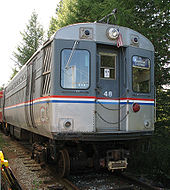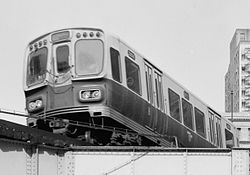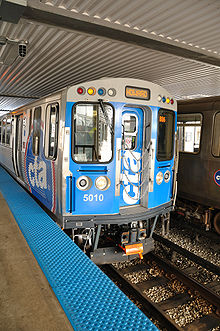- Chicago 'L' rolling stock
-
The rolling stock of the Chicago 'L' rapid transit system consists of 1,190 rail cars (all permanently coupled into 595 married pairs) dating from 1969 to 1994, delivered in four series: the 2200-series, 2400-series, 2600-series, and 3200-series, also known as the High Performance Family, because of innovative design and technological features from previous equipment in Chicago transit beginning with the former 2000-Series cars which operated between 1964 and 1993.
All cars are 12 ft (3.7 m) tall (from top of rail) and 48 ft 3 in (14.7 m) long (over coupler pulling faces). They are 9 ft 4 in (2.8 m) wide at the window sills but only 8 ft 8 in (2.6 m) wide at the door sills. Currently, all rail cars operating on the Chicago 'L' are DC power only; the next shipment of rail cars is expected to feature AC motors, but the traction power supply will continue to use DC.
Contents
Historic
Locomotives
Operator Manufacturer Delivered Retired Quantity Notes South Side Elevated Railroad Baldwin Locomotive Works 1892-93 1898 46 Vauclain four-cylinder compound locomotives. Retired when cars were converted to electric operation. Lake Street Elevated Railroad Rhode Island Locomotive Works 1893-95 1900 35 Retired when cars were converted to electric operation. Wooden cars
Operator Manufacturer Delivered Notes South Side Elevated Railroad Jackson and Sharp Company; Gilbert Car Company; Jewett Car Company 1892–1905 The earliest trains were originally pulled by steam locomotives (Baldwin Locomotive Works Vauclain four-cylinder compound locomotives); the South Side Rapid Transit was the first to use multiple unit electric cars. Lake Street Elevated Railroad Gilbert Car Company, Pullman Car Company; St. Louis Car Company and Co. Shop 1893–1909 The earliest trains were originally pulled by steam locomotives, cars subsequently converted to electric operation. Metropolitan West Side Elevated Railroad Pullman Car Company, Harland and Hollingsworth Company; American Car & Foundry, Barney and Smith Car Company; Jewett Car Company 1894–1907 Northwestern Elevated Railroad Pullman Company; American Car & Foundry; St. Louis Car Company; Jewett Car Company 1898–1908 Steel cars
Type Operator Manufacturer Delivered Retired Notes 4000 series Chicago Rapid Transit Company; later Chicago Transit Authority Cincinnati Car Company 1914-24 1973 5000 series Chicago Transit Authority Pullman Car Company (5001-02) and St. Louis Car Company (5003-04) 1947 1985 Built with PCC equipment 6000 series Chicago Transit Authority St. Louis Car Company 1950-59 1992 Built with PCC equipment 1-50 \ 61-65 series Cars Chicago Transit Authority St. Louis Car Company 1959–1960 1999 Built with PCC equipment 2000-series Cars Chicago Transit Authority Pullman-Standard 1964 1994 First of "High Performance" family 4000-series
 A pair of 4000-series "Plushie" cars at the Illinois Railway Museum.
A pair of 4000-series "Plushie" cars at the Illinois Railway Museum.
The 4000 series cars were manufactured by the Cincinnati Car Company, between 1914, and 1924. They were the first steel cars on the Chicago 'L' system. These cars were built in 2 distinct variants, with the earlier, metal-roofed cars being known as "Baldies" (due to their smooth iron roofs), and the later, wooden-roofed cars being known as "Plushies" (due to their more comfortable, green plush seats). The "Baldies" were equipped with 6 doors per car, however the center doors were never used regularly. The "Plushies" were equipped with only the end vestibule doors, but the cars internal structure was arranged to allow for the later addition of the center doors.
These cars were built as the result of several distinct purchases (dates are the date of the order, not the actual production date):
- December 29, 1913: 66 Trailer (non motorized) cars, numbered (4001-4066), and 62 motor cars, numbered (4067-4128),"Baldies", Longitudinal seating (Car 4005 later motorized and renumbered 4456)
- December 30, 1914: 122 Motor cars, numbered (4129-4250), "Baldies", Transverse seating.
- September 1, 1922: 100 Motor cars, numbered (4251-4350), "Plushies", Transverse seating.
- April 2, 1923: 5 Motor cars, numbered (4351-4355), "Plushies", Transverse seating.
- December 13, 1923: 100 Motor cars, numbered (4356-4455), "Plushies", Transverse seating.
The 445 cars of the 4000 series were the last Chicago 'L' cars purchased with air brakes.
When the State Street Subway opened in 1943, the older, wooden cars were not allowed to operate through it for safety reasons. The only cars available to operate in the subway were the 4000 series, which eventually led to production of the 5000 and 6000 series cars.[1]
5000-series
The 5000-series cars (numbered 5001-5004) were manufactured by the Pullman Car Company and the St. Louis Car Company. They arrived on CTA property in 1947. Only these four cars were ever built. These cars were the first 'L' cars to feature the "blinker door" configuration, in which the doors to the train open inward into the car rather than slide horizontally. This door configuration was then used on the 6000-series, 1-50 series, 2000-series and the 2200-series.
The technology for these cars was based on the Presidents Conference Committee streetcar but also borrowed design elements from the North Shore Line's Electroliners. The 5000-series was distinct in that each car was a three-piece articulated unit, the only cars on the 'L' system to ever feature articulation. They were also the first series of 'L' cars to be wider at the windowsills than at the doorsills to permit more interior space and still provide clearance for station platforms.
They were originally assigned to service on the Garfield Route (a precursor of today's Blue Line) before eventually being refitted with pantographs and renumbered 51 thru 54 for service on the Skokie Swift where they finished out their careers. The 5000-series was retired in 1985.[2]
6000-series
The 6000-series cars (numbered 6001-6722) were manufactured by the St. Louis Car Company and first delivered to the CTA in 1950. 130 were ordered originally with the series eventually totaling 720.
The 6000-series built upon the design of the 5000-series, using PCC technology and blinker doors. Unlike the 5000-series, the 6000-series units consisted of two cars coupled together in married-pairs, the first series of 'L' cars to be so designed.
A large percentage of these cars were built using trucks, motors, control equipment, seats, windows, and other components salvaged from Chicago's recently retired fleet of PCC streetcars.
The 6000-series saw service on all of the CTA's routes except the Skokie Swift. Use on Lake/Dan Ryan was however limited to emergencies and during car shortages in late 1969 and during the winter of 1979-80. The last of the 6000-series cars were retired in 1992.[3]
1-50-series
Main article: 1-50 series (Chicago 'L')The 1-50 series cars (numbered 1-50) were manufactured by the St. Louis Car Company and delivered to the CTA in 1959 and 1960. The cars were similar to the 6000 series design, but were double ended, single cars, as opposed to the 6000 series single ended, married pair configuration. The quarter point doors were adjacent to the operators cabs, allowing the operator to collect fares without leaving the cab. Like some members of the 6000 series, these cars utilized parts salvaged from Chicago's recently retired fleet of PCC streetcars.
Cars 1-4 were equipped for high performance test service, with higher horsepower motors, and were delivered in a distinctive maroon and silver gray paint scheme.
Originally assigned to the West-Northwest service, in later years these cars were found mainly on the Ravenswood, Skokie, and Evanston lines.
10 of these cars were converted in 5 married-pair sets, and renumbered 61a-b to 65a-b, and were utilized in Skokie service.
The last cars of the 1-50 series were retired in 1999. Seven cars of this series have been preserved by various railway museums.[4]
2000-series
Main article: 2000 series (Chicago 'L')The 2000 series cars (numbered 2001-2180) were manufactured by the Pullman Car Company and delivered to the CTA starting in 1964. Like the 6000 series before them, the 2000 series were built as married-pair sets. The cars had a number of modern features, including air conditioning, fluorescent lighting, large picture windows, and sculptured fiberglass front ends for the car bodies. The car bodies were mainly aluminum. These cars were the start of the High Performance Family.
The 2000 series more modern control systems initially prevented them from being used in a train with other types, until the delivery of the 2200 series and later cars.
The 2000 series had a fairly short service life of only 29 years, with all examples being retired by the beginning of 1994. Two cars are preserved at the Illinois Railway Museum and two more remain on CTA property stored at Skokie Shops. The rest were scrapped.[5]
Current
Type Manufacturer Delivered Rehabilitated Number produced Notes 2200-series Budd Company 1969–1970 1990–1992 150 Must be trained with cars of another type to meet ADA requirements 2400-series Boeing-Vertol 1976–1978 1987–1995 200 Cars 2401–2422 are capable of being utilized as work trains 2600-series Budd Company 1981–1987 1999–2002 600 3200-series Morrison-Knudsen 1992–1994 256 2200-series
Main article: 2200 series (Chicago 'L')The 2200-series cars (numbered 2201-2352) were manufactured by the Budd Company of Philadelphia, Pennsylvania and first delivered to the CTA in 1969 when the Dan Ryan branch (now known as the south end of the Red Line) was opened. 150 cars were ordered, and all delivered between 1969 and 1970. These cars, the oldest still in revenue service on the 'L', are the only CTA cars still to feature the "blinker door" configuration, in which the doors to the train open inward into the car rather than slide horizontally. These doors, which have a much narrower opening than the newer sliding doors, are unable to accommodate a wheelchair. Because of this, all 2200-series trains in the system must be coupled with another married pair of a different series car, usually the 2600-series, in order to comply with the Americans with Disabilities Act of 1990. In addition, during times when consists of more than four cars are operated, the 2200-series cars are relegated to "belly car" service (which means that they are not at either end of the consist).
The 2200-series also features fluted, unpainted stainless steel sides, a unique feature in the rolling stock until the addition of the 3200-series.
Cars 2307 and 2316 were renumbered 2351 and 2352; 2351 was originally numbered 2307 and re-paired after its mate 2308 was damaged in an accident at Addison/Kennedy in 1976; 2352 was renumbered from 2316 and paired with 2351 after 2315 was damaged in fire in Skokie Shops yard in 1977.
They were rehabbed by the New York Rail Car Corporation of Brooklyn, New York, between 1990 and 1992.
The 2200-series currently operates only on the Blue Line. The CTA plans to replace all of these cars with the new 5000-series cars starting in 2010.[6] However, as of June 2011, all 136 of the surviving cars remain in regular service.
2400-series
Main article: 2400 series (Chicago 'L') A 2400 series car heads a Green Line train at the corner of Wabash and Lake in the Loop
A 2400 series car heads a Green Line train at the corner of Wabash and Lake in the Loop
The 2400-series cars (numbered 2401-2600) were manufactured by Boeing-Vertol of Philadelphia, Pennsylvania and first delivered to the CTA in 1976 100 were ordered originally, with an option for an additional 100 (which was exercised, and the additional cars delivered through 1978). Currently, the cars are reaching the end of their expected service lifetimes and are to be replaced with the new 5000-series cars starting in 2010.[6] However, as of June 2011, most of the 191 surviving cars remain in regular service.
The first cars for the 'L' in many decades to feature sliding rather than "blinker" doors, the 2400-series also features smooth steel exteriors, ideal for decals and, in many cases, advertisements. As delivered, the cars featured a red, white, and blue color scheme on the front and rear of the cars, as well as stripes along the sides. These were modified several times over the years and the color has been removed from most cars at present, leaving them unpainted to match the bare stainless steel scheme of the rest of the fleet. Some cars feature advertising and cars 2401–2422 are "work" cars which are identified by red and white striping along their sides as well as on the front and rear of the cars. (Cars 2423-2424 were converted to "work" cars some time after 2401-2422 had been converted.)
They were rehabbed by Skokie Shops between 1987 and 1995.
In the 1990s, the 2400-series cars were used on the Red Line in mixed consists with unrefurbished 2600-series cars. While the 2600-series cars were being rehabbed, the 2400-series cars were used temporarily on the Red Line. Today, however, this series comprises the entire rolling stock for the Green Line and a sizeable portion of the Purple Line.
2600-series
Main article: 2600 series (Chicago 'L')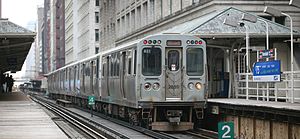 A 2600 series car brings up the rear of a Red Line train (temporarily rerouted through the elevated tracks of the Chicago Loop) at Randolph/Wabash.
A 2600 series car brings up the rear of a Red Line train (temporarily rerouted through the elevated tracks of the Chicago Loop) at Randolph/Wabash.
The 2600-series cars (numbered 2601-3200) were manufactured by the Budd Company, the same company that made the 2200-series, and first delivered to the CTA in 1981 in time for the upcoming O'Hare Airport extension of the Kennedy Line (now known as the northwestern end of the Blue Line). Originally, an order was made for 300 cars, but eventually this was doubled to 600, all of which were delivered between 1981 and 1987. They were the final cars ever constructed by Budd, later renamed to TransitAmerica. With 594 active cars, the series is by far the most abundant in the 'L' rolling stock. They were rehabbed by Alstom of Hornell, New York, between 1999 and 2002. They have few features to differentiate them from the earlier 2400-series, but nevertheless remain a mainstay of the 'L'.
These cars make up the entire Red, Pink and Yellow Line fleets and are also found on the Blue and Purple Lines.
3200-series
Main article: 3200 series (Chicago 'L')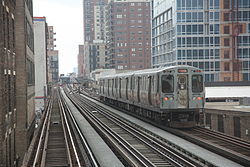 A 4-car train of 3200 series cars on the Orange Line, south of the Roosevelt elevated station.
A 4-car train of 3200 series cars on the Orange Line, south of the Roosevelt elevated station.
The 3200-series cars (numbered 3201-3457) were manufactured by Morrison-Knudsen of Hornell, New York, and first delivered to the CTA in 1992. The original order for 256 was motivated primarily by the impending opening of the Orange Line, which would need new cars when it opened in October 1993.[6] The order was completed in 1994.[7]
The 3200-series contains many innovations over the previous 2600-series. Computers control much of the cab functions and simplify operation for the motorman. Diagnostics are also easier to perform on this series than on previous series. In addition, fluted steel siding is included on these cars for the first time since the 2200-series, in order to reduce graffiti. The series also introduced openable hopper windows for use in case of air conditioner failure.[7]
Cars 3441-3456 were originally equipped with pantographs for use on the Yellow Line, which was powered by overhead lines until 2004. The pantographs on 3451-3456 were removed in the late 1990s when they were reassigned to supplement the Brown Line, while the rest lost their pantographs when the Yellow Line was converted to third rail power in 2004.[7]
Car 3457 was an additional car built specifically for the purpose of serving as a mate to the 2600-series car 3032, whose mate had been damaged. 3032 was subsequently renumbered 3458.[8]
The 3200-series cars are currently assigned to the Orange and Brown Lines, composing their entire fleets. At various points during their service life a small number were also assigned to the Yellow and Purple Lines.
5000-series
Main article: 5000 series (Chicago 'L')The next series of rail cars, expected to replace the aging 2200-series and 2400-series cars, is the 5000-series.[9] The series was built by Bombardier. The CTA received ten prototype cars in 2009, which underwent testing,[10] and began operating in 2011.[11] The order is for 406 cars, with options for up to 300 more.[6] The Chicago Transit Authority planned to put the first ten cars into in-service testing in mid-April 2010.[12] The first in-service test run was made on April 19.[13][14][15]
Originally assumed to be the 3500-series, the procurement of these cars experienced several delays, including a cancellation of the original bid announcement in 2002.[16]
- Type: 5000-series Cars
- Builder: Bombardier Transit Corporation
- Delivery Date: 2009–?
New features
- AC motors
- New LED signs
- Predominance of longitudinal seating
- The seat fabric will be upgraded to an anti-stain/anti-microbial fabric newly available in the industry.
- Train operators will be able to view live video from any railcar when the passenger intercom unit is activated. This will ensure operators are better able to immediately provide information to first responders.
- Adding cellular modems to railcars will allow the CTA's Control Center to communicate directly with customers in real-time via audio and text messages using speakers and six visual displays in each car.
- In the future, suitably equipped emergency vehicles could also access rail car video through the wireless connection.
- New door action.[clarification needed]
See also
References
- ^ "4000-series Cars". Chicago-'L'.org. http://www.chicago-l.org/trains/roster/4000.html. Retrieved 2009-02-22.
- ^ "5000-series Cars". Chicago-'L'.org. http://chicago-l.org/trains/roster/5000.html. Retrieved 2009-01-25.
- ^ "6000-series Cars". Chicago-'L'.org. http://chicago-l.org/trains/roster/6000.html. Retrieved 2009-01-29.
- ^ "1-50 \ 61-65 series Cars". Chicago-'L'.org. http://www.chicago-l.org/trains/roster/1-50.html. Retrieved 2009-02-22.
- ^ "2000-series Cars". Chicago-'L'.org. http://www.chicago-l.org/trains/roster/2000.html. Retrieved 2009-02-22.
- ^ a b c d "CTA Selects Manufacturer for New Rail Cars". Chicago Transit Authority. 2006-05-10. http://www.transitchicago.com/news/default.aspx?Month=5&Year=2006&Category=&Archive=y&ArticleId=709. Retrieved 2009-01-05.
- ^ a b c "3200-series Cars". Chicago-'L'.org. http://www.chicago-l.org/trains/roster/3200.html. Retrieved 2007-07-30.
- ^ "Frequently asked questions #4.4". Chicago-'L'.org. http://www.chicago-l.org/FAQ.html#4.4. Retrieved 2007-07-30.
- ^ "President's Report". Chicago Transit Authority. 2008-01. http://www.transitchicago.com/assets/1/board_presentations/0801presidentsreport.pdf. Retrieved 2009-01-05.
- ^ "CTA to Issue Bonds to Complete Purchase of New Rail Cars" (Press release). Chicago Transit Authority. 02-10-2010. http://www.transitchicago.com/news/default.aspx?ArticleId=2561. Retrieved 2010-04-14.
- ^ "Clean Vehicles:Trains". Chicago Transit Authority. http://www.transitchicago.com/goinggreen/vehicles.aspx#train. Retrieved 2010-04-14.
- ^ "CTA to Begin In-Service Testing of New Rail Cars" (Press release). Chicago Transit Authority. April 15, 2010. http://www.transitchicago.com/news/default.aspx?Month=&Year=&Category=2&ArticleId=2601. Retrieved April 15, 2010.
- ^ Roberts, Bob (April 19, 2010). "New CTA trains make first run". WBBM. http://www.wbbm780.com/New-CTA-trains-make-first-run-PHOTOS/6840324. Retrieved April 20, 2010.[dead link]
- ^ Jackson, Cheryl V. (April 20, 2010). "New CTA cars: 'Cleaner, looks a lot safer'". Chicago Sun-Times: pp. 9. http://www.suntimes.com/news/transportation/2176528,CST-NWS-cta20.article. Retrieved April 20, 2010.
- ^ http://www.youtube.com/watch?v=n6eE7UGCKmk
- ^ "Frequently asked questions #4.10". Chicago-'L'.org. http://www.chicago-l.org/FAQ.html#4.10. Retrieved 2007-07-30.
External links
- "CTA Car Assignments". Chicago-'L'.org. http://www.chicago-l.org/trains/assignline.html. Retrieved 2007-01-31.
- "2200-series Cars". Chicago-'L'.org. http://www.chicago-l.org/trains/roster/2200.html. Retrieved 2007-01-31.
- "2400-series Cars". Chicago-'L'.org. http://www.chicago-l.org/trains/roster/2400.html. Retrieved 2007-01-31.
- "2600-series Cars". Chicago-'L'.org. http://www.chicago-l.org/trains/roster/2600.html. Retrieved 2007-01-31.
- "3200-series Cars". Chicago-'L'.org. http://www.chicago-l.org/trains/roster/3200.html. Retrieved 2007-01-31.
Chicago 'L' Lines Red Line · Orange Line · Yellow Line · Green Line · Blue Line · Purple Line · Brown Line · Pink Line · LoopDefunct lines Stock Yards · Kenwood · Normal Park · Market Street · Metropolitan Main Line · Garfield Park · Westchester · Humboldt Park · Northwest · Randolph Street · CuylerStations Current stations · Former stationsRolling stock Defunct: 4000 · 5000 · 6000 · 1-50 · 2000
Current: 2200 · 2400 · 2600 · 3200 · 5000Operators Other Chicago Central Area Transit Plan · CTA Holiday Train · Mid-City Transitway · 1977 Chicago Loop derailmentCategories:
Wikimedia Foundation. 2010.

